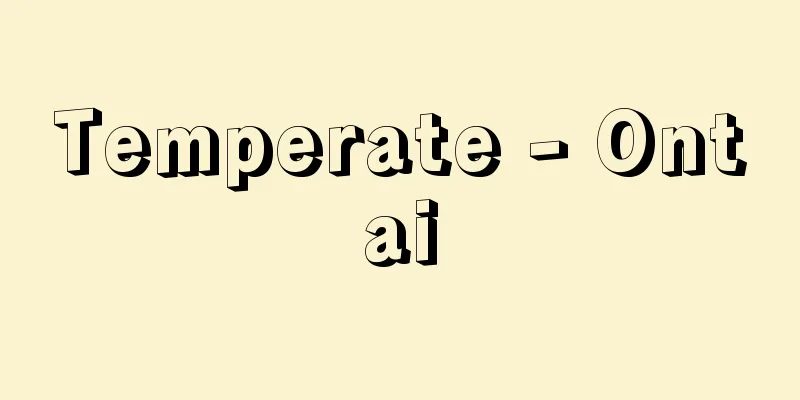Temperate - Ontai

|
A climate zone in the mid-latitudes, between the tropical zones at low latitudes and the polar zones at high latitudes. In mathematical climate zones, it refers to the zone between the Tropic of Capricorn (23°26') and the Polar Circle (66°33'). Zupan defined the temperate zone by isotherms, setting the border with the tropical zone at an annual mean temperature of 20°C and the border with the polar zone at an annual mean temperature of 0°C. The most commonly used definition of temperate zone today is the Köppen definition of the zone with an average temperature of -3°C to 18°C in the coldest month. The zone between the isotherm of the warmest month average temperature of 10°C and the coldest month average temperature of 18°C is the temperate zone in the broad sense, and the cold temperate zone or subpolar zone is the zone with an average temperature of -3°C or less in the coldest month. The rest of the zone is the temperate zone in the narrow sense. In general, this refers to the temperate zone in the narrow sense. The temperate zone generally spans between 30 and 50 degrees latitude, but due to the distribution of water and land masses and large topography, the isotherms are not necessarily parallel to the latitude lines, and are significantly out of alignment, especially on the west and east coasts of continents. In terms of mathematical climate zones, the temperate zone accounts for about 25% of the Earth's surface, where the sun never sits directly overhead throughout the year, but there are also no days when the sun never appears above the horizon. The temperate zone, according to the Köppen classification, is much larger in the Northern Hemisphere than in the Southern Hemisphere, which has more ocean. The temperate zone is an area where the westerly winds prevail, and the seasonal changes are more pronounced than in the tropical, subtropical, subarctic, and polar zones. Compared to the polar and subtropical zones, the temperate zone generally receives more rainfall and has a higher population density. This is thought to be because the winters are not as cold and the summers are not as dry, there are many agricultural crops, and it is an area where it is easy to be active. [Nozomi Kobayashi and Yoshitaka Fukuoka] VegetationIn plant ecology, the temperate zone includes both summer green forests and coniferous forests in a broad sense, but is often used to refer to the summer green forest zone in the narrow sense. In Japan, the temperate zone is often divided into cool temperate zone (summer green forest zone) and warm temperate zone (evergreen broad-leaved forest zone), and the term temperate zone in the narrow sense is sometimes used to refer to the cool temperate zone and the warm temperate zone to the warm temperate zone. The temperate zone in the narrow sense refers to the summer green forest zone in the mid-latitudes, and in the Northern Hemisphere, it is an area where forests of beech, oak, maple, and linden trees are native. Summer green forests are most commonly developed in the eastern part of North America and both ends of Eurasia, from China to Japan, and in Europe. In other areas, they are steppe or steppe forest due to the dryness. [Tatsuyuki Ohba] [Reference] | | | | | | |Source: Shogakukan Encyclopedia Nipponica About Encyclopedia Nipponica Information | Legend |
|
中緯度にある気候帯で、低緯度の熱帯と高緯度の寒帯との間にある。数理気候帯では回帰線(23度26分)と極圏(66度33分)に挟まれた地帯をさす。ズーパンは温帯を等温線によって定め、熱帯との境界を年平均気温20℃、寒帯との境界を年平均0℃とした。現在もっともよく使われている温帯の定義は、ケッペンによる最寒月の平均気温零下3℃から18℃の地域とする考え方で、最暖月平均気温10℃の等温線と、最寒月平均気温18℃に挟まれた地帯を広義の温帯、そのうち最寒月の平均気温零下3℃以下の地域を冷温帯あるいは亜寒帯とし、その分を除いた地帯を狭義の温帯とする。一般的には狭義の温帯をさす。位置的な温帯の範囲は緯度30度から50度程度にだいたいまたがっているが、水陸分布や大地形の影響で等温線がかならずしも緯線に平行しておらず、とくに大陸の西岸と東岸ではかなり位置がずれる。数理気候帯では温帯は地球上の約25%を占め、そこでは1年を通じて太陽が真上にくることはないが、太陽がまったく地平線上に現れない日もない。ケッペンの区分による温帯の範囲は北半球のほうが海洋の多い南半球よりもかなり大きい。 温帯は偏西風の卓越する地域で、季節の移り変わりが熱帯、亜熱帯、亜寒帯、寒帯より顕著に現れる。寒帯や亜熱帯に比較して一般に降水量が多く、人口密度も高い。これは冬の寒さも、夏の乾燥も極端ではなく、農作物も多く、活動しやすい地域であるからと考えられる。 [小林 望・福岡義隆] 植生植物生態学上の温帯は、広義には夏緑林帯、針葉樹林帯を含むが、狭義には夏緑林帯に対して用いられることが多い。また日本では、温帯を冷温帯(夏緑林帯)と暖温帯(照葉樹林帯)とに区分することも多く、冷温帯に対して狭義の温帯を、暖温帯に対して暖帯の名をあてることも行われる。狭義の温帯は中緯度地帯の夏緑林帯をさし、北半球ではブナ属、ナラ類、カエデ類、シナノキ類などの森林を本来とする地域である。夏緑林帯のもっともよく発達するのは、北アメリカの東部とユーラシアの両端、すなわち中国から日本にかけての地域とヨーロッパである。その他の地域では、乾燥のためステップまたはステップ林となっている。 [大場達之] [参照項目] | | | | | | |出典 小学館 日本大百科全書(ニッポニカ)日本大百科全書(ニッポニカ)について 情報 | 凡例 |
<<: Temperate summer rainy climate - Ontainatsuamekiko
Recommend
Ghazal - Ghazal
…3-year course. École nationale supérieure d'...
Mehta - Zubin Mehta (English spelling)
1936- Indian conductor. After being trained by his...
Hufe (English spelling)
A general term for the rights enjoyed by village c...
Keratella cochlearis (English spelling)
...Their diet includes phytoplankton, water fleas...
Republic of Gilan (Soviet) Republic of Gīlān
A local revolutionary government in Iran. It was p...
How to use - How to use
〘noun〙① A place where meals are prepared. Also, th...
Harmony Society
A Lutheran community established in Pennsylvania i...
Maas
…It has a total length of about 950 km and a drai...
Sayyd Muhammad Abdille Hassan
… [Hideo Oda]. … *Some of the terminology that re...
Forest soil - Shinrindojo
This refers to soil distributed in forested areas....
Rebellion of the Kibi Clan
The Nihon Shoki contains three legends. In the ent...
Huang-Lao (English spelling)
This refers to Chinese Taoist thought, especially ...
Kamioouchizawa National Forest
...The Gojome Highway (currently National Route 2...
Zygentoma
…A general term for insects belonging to the Zyge...
HE - Amberger
… In the late 1950s, several groups studying the ...









